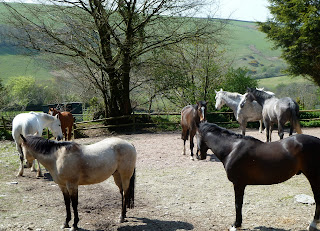Up on Exmoor we've had 4 or 5 wet summers in a row so at least we are used to it but what if these long, wet, growing summers are a sign of things to come? Quite apart from the fact that we will all need extra sets of waterproofs, it may help kickstart a rethink in how we keep our horses.
Till now, one of the big differences between those who keep their horses on livery yards and those who keep them at home has been that - at home - you can be more creative about how you manage your horse. For instance, if you want to restrict grazing you can use tracks whereas many yards currently only offer the choice of stable or turnout.
However, with sodden, waterlogged fields liable to poaching even in summer and dangerously lush grass becoming ever more common then finding an alternative (which keeps horses from damaging fields AND protects them from high grass sugars) could become a much more attractive option for livery yard owners.
If you're a yard owner it could be the time to look seriously at using tracks. Consider the benefits, not just for your business but for your land and your clients' horses.
- Tracks preserve and protect valuable pasture. Because horses can be turned out on tracks even in the wettest weather, there is no risk of them poaching fields. Pasture can then be used to take a forage crop and hay or haylage fed on the tracks in bad weather or when grass is risky for horses.
- A relatively small acreage with a track system can support many more horses than the same area simply used as fields. In addition, tracks can utilise marginal land - old yards, areas of hardcore, woodland and other areas which would not normally be useful for turnout.
- Horses love tracks! Tracks allow sociable interaction, increase movement, minimise stable vices and reduce the risk of laminitis and other grass-related conditions (which are all the more likely on intensively managed modern pasture). Tracks also mean that horses don't have to slosh around in mud when they are turned out.
- For an interesting article on the links between intensively farmed grass, mineral deficiencies and head-shaking in horses take a look here: http://www.calmhealthyhorses.co.nz/neuro/flicker.html
Initially of course there is an outlay in setting up a track, but it doesn't need to be exorbitant. If you are a horse owner, let your yard owner know that you would value track turnout - demand creates supply, after all! Twenty years ago few yards had arenas but now they are regarded as essential to a well run yard. In a few more years, perhaps we will be able to say the same about tracks.
For more information, have a look at these links:
http://rockleyfarm.blogspot.com/2010/09/more-about-tracks.html
http://rockleyfarm.blogspot.com/2010/10/final-tracks-instalment.html
http://rockleyfarm.blogspot.com/2010/10/final-tracks-instalment.html














3 comments:
Amen to this!
Even a small area can be made so much more usable if you have tracks. We only have two acres, but I have nice pastures (except in the drought) because of the track we have. I can allow the boys out to graze only when it's appropriate, and for short periods of time, but they still get plenty of exercise on the track. The biggest issue I have is drainage - our land is quite flat - so they don't get to go out when it's wet. That's usually not much of a problem here, but if it were, I would definitely look at ways to make our track all-weather.
Great post! It really gets you thinking, and you are so right, yard owners need to know if this is what people want, and to be aware of why it really can work to everybody's benefit (I can only begin to imagine the blank looks I'd get from my 70 year-old farmer/yard owner though ;0) . Ho hum...)
Jen - post pics - it would be so great to have a selection of track pics :-)
M's mum - you'd be surprised...Start talking to 70 yr old farmers round here and you uncover stories of ponies hunting and working without shoes, sheep being trotted 5 miles along the roads to keep their feet sound...and farmers mostly know more than horse owners about the mineral levels in their fields...Add to that the amount of dietary-induced lameness in cattle and you'd be surprised how sympathetic he might be...
Post a Comment